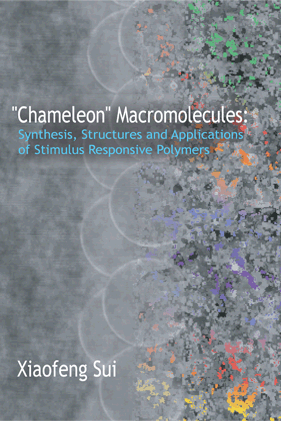
This Thesis describes the preparation and characterization of addressable responsive polymer structures and their versatile applications. Stimuli responsive polymer chains including temperature responsive poly(N-isopropylacrylamide), PNIPAM, pH responsive poly(methacrylic acid), PMAA and redox responsive poly(ferrocenylsilane) PFS can be assembled into various functional polymer architectures such as polymer grafts on surfaces by “grafting to” and “grafting from” approaches and polymer networks in bulk including macroscopic hydrogels and microgels/nanogels systems.
In
Chapter 2 is covering polymer grafts, macroscopic hydrogels and microgels/nanogels. The general background of stimuli-responsive polymer materials is highlighted. The approaches used to obtain the various structures are also introduced.
In
Chapter 3, the behavior of PNIPAM grafts with three different grafting densities under varied solvent and temperature conditions is described. The grafts are prepared by a “grafting from” approach, using surface-initiated atom transfer radical polymerization (SI-ATRP) from substrate-immobilized monochlorosilane- or trimethoxysilane-functional ATRP initiators. In-situ spectroscopic ellipsometry is used to study the temperature-induced collapse of PNIPAM grafts as a function of phase state across the lower critical solution temperature (LCST) in real time. A model involving a bi-layer with a gradually changing density profile is presented, which adequately fitted the data therewith enabling a quantitative discussion of the reversible thickness change.
The effect of co-nonsolvency, as well as grafting density on the mechanical properties, more specifically the apparent Young’s moduli of these PNIPAM grafts are studied using an AFM based colloidal probe nano-indentation method. The collapse dynamics of the PNIPAM grafts is investigated by monitoring the change of adherence between the grafted surface and the colloidal probe. AFM based friction force microscopy, utilized to investigate the stimulus-induced tribological behavior, shows that the friction coefficient of PNIPAM grafts in water and in the co-nonsolvent differs.
The trimethoxysilane-anchored PNIPAM grafts are found to be much more stable than the monochlorosilane ones under cell-culture medium conditions. The trimethoxysilane-anchored polymer grafts are evaluated as supporting substrates for MC-3T3 cell cultures. At 37 °C (T> LCST), the seeded cells adhere, spread, and proliferate, whereas at 25 °C (T< LCST), the cells detach from the surface. The low density polymer grafts show the highest cell adhesion, featuring adhering cells with an elongated morphology.
Chapter 4 describes the preparation and characterization of mixed polymer grafts consisting of PNIPAM and PMAA. The mixed grafts are also prepared by “grafting from” approaches, a sequential combination of SI-ATRP and iniferter-mediated photopolymerization (SI-IMP). The responsive behavior as a function of pH is investigated. Reversible structural reorganization, variation of grafts thickness and of wetting characteristics are monitored.
Utilizing a "grafting to" approach - amine alkylation reaction, PFS chains (poly(ferrocenyl(3-iodopropyl)methylsilane), PFS-I) are tethered onto silicon or gold substrates. Robust, relatively dense redox-active films with a height of around 10 nm are successfully formed by reaction of PFS-I with amine-terminated monolayers on silicon or gold surfaces.<br /><br />
In
Chapter 5, the electrochemical properties of these PFS grafts are studied both in water and organic media. Information on the properties of these films as a function of redox state is gained using quantitative adherence measurements between the films and AFM tips. An ascorbic acid electrochemical sensor based on these surface-anchored PFS chains, exhibiting a high sensitivity and stability, is also fabricated.
As mentioned in Chapter 5, the iodo groups of PFS-I could be easily replaced by a variety of nucleophiles under mild conditions, thus forming highly taylorable redox-active derivatives. The weak nucleophile sodium acrylate could be attached in the presence of the crown ether 15-crown-5 with quantitative conversion, giving a crosslinkable PFS bearing acrylate side groups (PFS-acryl).<br /><br />
In
Chapter 6, by using PFS-acryl as precursor, a rapidly forming redox responsive PFS-poly(ethylene glycol) (PFS-PEG)-based macroscopic hydrogel is generated via thiol-Michael addition click reaction. The equilibrium swelling ratio, morphology, dynamic mechanical properties and redox responsive properties of the hydrogel are studied.
PFS-acryl could also copolymerize with other monomers with different ratios to form various networks.<br /><br />
In
Chapter 7, multi-responsive macroscopic hydrogels composed of PNIPAM and PFS are formed by photopolymerization of NIPAM and PFS-acryl. Crosslinking occurs under mild conditions, providing homogeneous hydrogels. The thermo-responsive properties of the hydrogels are studied as a function of the PFS oxidation state. The in-situ fabrication of silver nanoparticles inside the hydrogel network via reduction of silver nitrate is also described. These composites show strong antimicrobial activity while maintaining a high biocompatibility with cells.
In
Chapter 8, the preparation of PFS microgels/nanogels is described. Besides the PFS–acryl studied in Chapter 6 and Chapter 7, a new type of crosslinkable, water soluble PFS, PFS with vinyl imidazole groups (PFS polyionic liquids, PFS-PILs) is developed. PFS-PIL is also derived from PFS-I, by reacting with 1-vinylimidazole at 60 °C for 24 h. To increase the water solubility of the formed polycation, its iodide counterions are exchanged with chloride counterions by dialysis in 0.1 M aqueous sodium chloride. PFS-PIL self-crosslinks at low concentrations into nanogels or forms macroscopic hydrogel networks at higher concentrations. PFS-PIL also proves to be an efficient dispersant in the microemulsion polymerization of methyl methacrylate, producing stable PFS-poly(methyl methacrylate) latex suspensions. Using PFS-PIL and PFS-acryl as precursors, uniform sized PFS microgels are obtained by using a microfluidic system coupled with UV photopolymerization. This novel, facile, flexible and straightforward microfluidic technique enables us to generate and precisely control the size of these redox responsive microspheres. These PFS nanogels/microgels produced show redox responsive properties and promising applications in catalysis and molecular release.